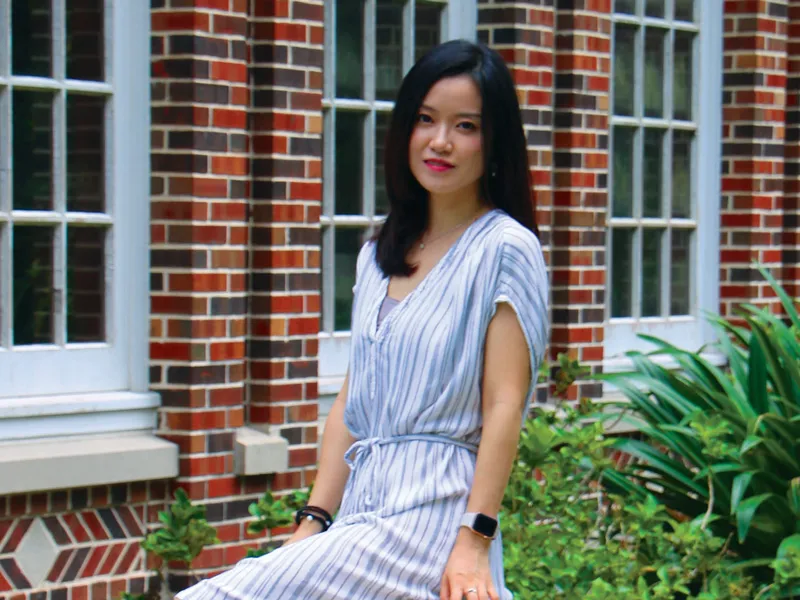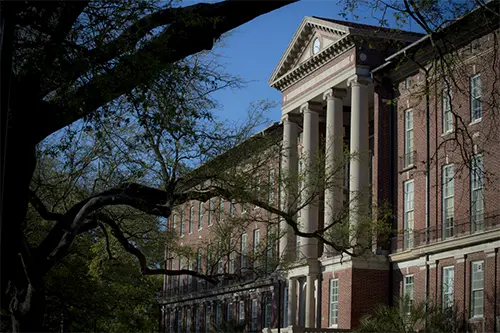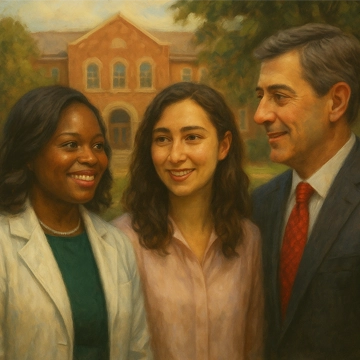
Fan Zhang, Jessie J. Poesch Professorship in Art, assistant professor in Asian Art at the Newcomb Art Department, Tulane’s Asian Studies Program, and Medieval and Early Modern Studies Program.
Originally published in the 2025 issue of the School of Liberal Arts Magazine
Long before it became the focus of her fieldwork and current book project, Fan Zhang was drawn to ancient burial sites. Growing up in Chengdu, a city in Southwestern China, she remembers riding her bike to the royal tomb of a Ming dynasty prince and taking the bus to the Bronze-Age burial pits of Sanxingdui. “The most fun trips I remember were not to zoos or amusement parks,” she says, “but to burial sites and ancient remains.”
Today, Zhang is an assistant professor in Asian Art and holds the Jessie J. Poesch Professorship in Art at Tulane. As an art historian, she specializes in the material culture of early medieval China. Her book-in-progress, A Center on the Border: Migration, Identity, and Cosmopolitanism in Fifth-Century Chinese Art, explores the mortuary art of 300 burial sites in Pingcheng, a city in Northern China that served both as the capital of the Northern Wei dynasty (386–534) and as a border between nomadic steppes and China proper. Rather than focus on the distinction — and tension — between the Han Chinese and the nomads in Pingcheng, as traditional historiographies have done before, Zhang’s project reveals a more nuanced story of cultural pluralism, and of the creativity and innovation that emerged out of this transcultural exchange.
Zhang has come a long way from her childhood wanderings. Her research has earned support from prestigious institutions, including a 2025 Mellon Fellowship at the Institute for Advanced Study (IAS) at Princeton, a nearly $50,000 Award to Louisiana Artists & Scholars (ATLAS) grant from the Louisiana Board of Regents, and upcoming residencies at the Chinese University of Hong Kong and Fudan University. Though her process now includes archival research, months spent in the field, and collaboration with local scholars, she maintains a sense of wonder and excitement in her work.
One striking discovery was the tomb of Han Farong, a woman of a non-noble background who, despite the plain appearance of her tomb, was buried with an extraordinary set of jewelry, including a necklace of over 4,000 Indo-Pacific beads and an intricate pair of gold earrings designed with Indo-Bactrian motifs. The jewelry, Zhang explains, shows the cosmopolitan fashion at Pingcheng — that luxury goods and the foreign exotic were not restricted to royals or aristocrats, but were likely available to any city dwellers who could afford them.
She is also working on a 3D model of the tomb of Lady Poduoluo, a member of a non-Han ethnic group whose funerary portraits depict her seated equally with her husband — in distinct contrast to typically male-centered Han Chinese funerary art. The couple’s clothing blends Han and Xianbei styles, and Buddhist references appear in the mural composition. Dominating historical narratives assume the nomads simply assimilating into Han Chinese culture, but such findings prove the syncretism of cultures and give agency to the immigrants who played an important role in China’s artistic development and history.
When Zhang first left China to pursue her PhD at the Institute for the Study of the Ancient World (ISAW), New York University, she experienced a shift in identity — from a member of the dominate majority in China, as Han Chinese herself, to a minority group in the United States. “This led me to consider the relationship of ‘us’ and ‘other,’ and the shifting and multiple identities one could have,” she says. In New York City, she experienced “true cosmopolitanism,” and began understanding the mechanism of cities as a place “where people from diverse backgrounds share the urban space and create something extraordinary and impossible for a closed society.”
Zhang sees border cities — particularly those like Pingcheng — not as sites of division, but as “contact zones for cultural interaction.” She hopes that this book will highlight the unique position of all borders, and emphasize migration as key to artistic innovation. Rooted in her love of fieldwork is the desire to eschew simple definitions, embrace complexity, and question our definitions of “center” and “periphery.” “I focus on individuals who facilitated and embodied these interactions, rather than label them generally,” she explains. “By investigating individual burial remains, it reveals a more nuanced picture than the binary divisions.”
Fan Zhang holds the Jessie J. Poesch Professorship in Art, is an assistant professor in Asian Art in the Newcomb Art Department, a core faculty member of Tulane’s Asian Studies Program, and an affiliated faculty member of the Medieval and Early Modern Studies Program (MEMS). Her teaching encompasses a diverse range of subjects, including East Asian art, Silk Road studies, Chinese funerary art, Buddhist art, material culture, and women and gender. Zhang is a member of the Institute of Advanced Study, where she was recently awarded a prestigious fellowship for the 2025-26 academic year.




